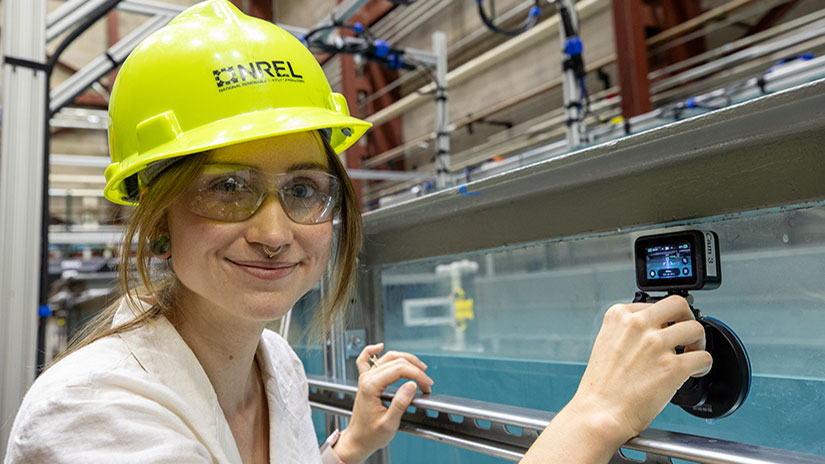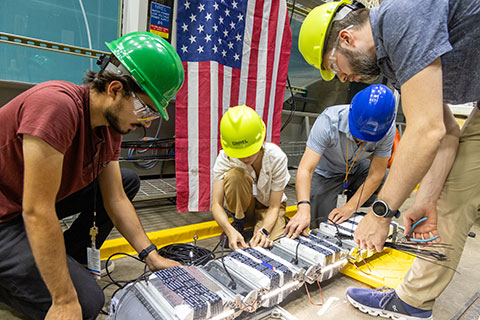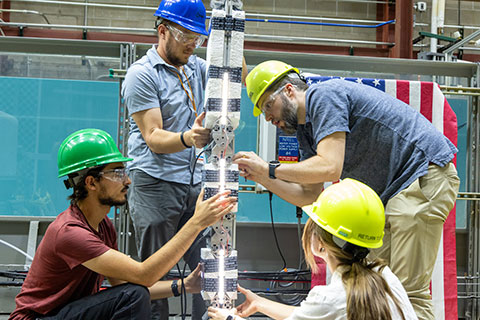Aquatic Acrobatics: University Collaboration Visualizes the Future of Flexible Wave Energy
A Ph.D. Student, Her Professor, and a Team of NREL Researchers Pioneer Visual Diagnostics to Characterize Flexible Wave Energy Devices

University of Florida Ph.D. candidate Isabel Hess uses motion tracking and computer vision to optimize flexible wave energy converters at NREL’s Sea Wave Environmental Lab. Photo by Greg Cooper, NREL
Recently, inside the Sea Wave Environmental Lab at the National Renewable Energy Laboratory’s (NREL’s) Flatirons Campus, Isabel Hess prepared to perturb a flexible wave energy converter (flexWEC) prototype from its equilibrium position.
A crane hoisted the flexWEC over the waters of a 13,000-gallon testing tank, centering it above the tank before lowering the device into its depths. Magnets snapped and secured the device to the tank’s floor. Above the water's surface, operators unhooked the flexWEC from the crane.
Outside the tank, Hess switched on four waterproof strips of LEDs along the side of the flexWEC and set up three different cameras to form what is called a visual diagnostic system. Hess began recording as a technical team member switched on the tank’s wave generators, causing the flexWEC to bend and sway in the simulated ocean waves. Hess’ three cameras captured the device’s movements, which were highlighted—literally—by the LED strips. Later, Hess would use motion-tracking techniques and computer vision to analyze the flexWEC's underwater undulations.
“Perturb means ‘change,’ and the device’s equilibrium is its upright position,” Hess explained. “When waves push the device out of this position, my cameras capture the device’s deformations, or movements. This visual data will help us assess the device’s performance under different wave conditions, which will guide us in optimizing future versions.”
Hess is a Ph.D. student in mechanical engineering at the University of Florida who primarily studies underwater soft robotics through the university’s Fluids & Adaptive Structures Lab. She is also a fellow of the U.S. Department of Energy’s (DOE’s) Marine Energy Graduate Student Research Program, which provides access to experts, resources, facilities, and funding support, including a monthly stipend and tuition reimbursement.
This fellowship is why Hess recently demonstrated that device in NREL's wave tank. Hess and her professor, Patrick Musgrave, joined Blake Boren, a senior engineer at NREL, to study a new wave energy device called an origami flexWEC. This is a type of distributed embedded energy converter technologies (DEEC-Tec)-based ocean wave energy converter.

A DEEC-Tec-based ocean wave energy converter combines many small energy converters to form larger energy conversion structures—like that perturbed origami flexWEC—to capture energy more efficiently. Unlike other wave energy devices, which historically were made from large, rigid bodies with concentrated surface area for converting energy, DEEC-Tec-based converters such as the origami flexWEC can be highly flexible, allowing them to capture energy from a broad range of ocean wave periods and wave heights. That flexibility makes them more durable, as a DEEC-Tec device can bend like seagrass to endure powerful waves. In the case of the origami flexWEC, the device can fold itself, making it smaller and less vulnerable to storm waves and allowing for greater ease of transport and deployment.
“When you have a lot of force concentrated on a specific WEC surface area, it’s more likely to fail,” Musgrave explained. “With DEEC-Tec, you have many points throughout the structure, flexing, bending, harvesting, and converting ocean wave energy. The prototype we're testing today is one of many first steps toward that type of device.”
Visual Diagnostics for DEEC-Tec Integration
For DEEC-Tec to be integrated into other wave energy converter research and development, the DEEC-Tec team needs to know how to distribute and embed energy converters across different types of structures so that a given DEEC-Tec device can effectively generate electricity, last longer, and adapt to various ocean conditions. That is where Hess and her visual deformation diagnostic system come in.
Hess’ motion tracking analysis allows her to accurately assess the device’s deformations as it flexes back and forth in the simulated ocean currents of the lab’s wave tank. Because the device is a prototype, Hess’ system is a simplified version of the complex analysis that will inform the development of future DEEC-Tec devices.
“Currently, there is no off-the-shelf solution for characterizing underwater deformations for DEEC-Tec-based ocean wave energy converter concepts,” Boren said. “Isabel's research in motion tracking and computer vision helps fill this gap by allowing us to measure these underwater deformations and will be hugely impactful for designing, analyzing, and optimizing efficient, DEEC-Tec-based ocean wave energy converters such as origami flexible WECs.”
The Future of FlexWECs
In another step toward more DEEC-Tec-based ocean wave energy converter concepts, Hess and Musgrave are also supporting Boren and his team by characterizing a new type of energy converter called a HASEL (short for hydraulically amplified self-healing electrostatic).
A HASEL is an energy transducer that can move when electricity is applied or generate electricity when an external energy source—like an ocean wave—causes it to deform. Traditional electrical generators—including that perturbed origami flexWEC prototype—rely on metals, copper, and magnets. HASELs do not require any of those materials, so they can be less expensive to manufacture. In addition, HASELs are easier to distribute across a device. Instead of a structure that relies on a few fixed rotational points, a HASEL-integrated device could potentially use hundreds or thousands of HASELs woven together to create a structure that can twist, bend, and stretch in many different directions.
“This approach could provide a continuous flexible structure and also make it more adaptable to a broader range of ocean wave frequencies and periods,” Hess explained. “Rather than being limited to just a few degrees of freedom, you essentially gain a continuous range of motion.”

Boren (top left), Musgrave (top right), Hess (bottom right) and Chamot (bottom left) run final checks on the origami flexWEC, whose strips of waterproof LED lights are visible along the side. These lights help Hess’ cameras capture the device’s underwater movements. Photo by Greg Cooper, NREL
But first, the team needs to understand how individual HASELs operate. To this end, Hess is investigating how much electricity a single HASEL can produce based on the amount of force applied and the level of electrical charge applied to the HASEL before it generates electricity. This information will help the team characterize the performance of HASELs and explore ways to integrate them into larger wave energy converter structures.
“We’ve determined that HASELs are more efficient at converting external mechanical forces into electricity than we initially anticipated,” Boren said. “This tells us that they are worth further research to enhance their efficiency as energy converters.”
The Team Surges Forward
Hess is optimistic as she looks forward to her next few months at NREL.
“My specialty areas—characterizing HASELs and using cameras to capture kinematics—have been going well,” Hess said. “Next spring and summer, I’ll bring those pieces together to round out my thesis.”
Boren and Musgrave—who were respectively a postdoctoral researcher and a graduate student at Virginia Tech at the same time—are proud of the collaboration between NREL and the University of Florida. They value the partnership for its contributions to ocean wave energy technology development and for allowing a student researcher to gain paid experience working with a national laboratory.
“One of the most influential experiences in my life was when someone took a chance on me and helped fund my Ph.D.,” Boren said. “We wanted to offer a similar opportunity to someone who could contribute to DEEC-Tec. With her experience in soft robotics and fluid-structure analysis, Isabel had the expertise we needed.”
In addition, Boren and Musgrave hope this work sparks continued collaboration between NREL and the University of Florida and among the larger marine energy community.
“DEEC-Tec broadens our community with new perspectives, technological domains, and materials we’ve never used in ocean wave energy before,” Boren said. “It really does represent an opportunity to be more innovative in how we think about ocean wave energy.”
The DEEC-Tec project is funded by the DOE Water Power Technologies Office.
Applications for the 2025 Marine Energy Fellowship are open through Dec. 6, 2024. Apply today! Then, subscribe to The Current newsletter and check out NREL's marine energy page to learn about the latest water power and marine energy research.
Last Updated May 28, 2025
